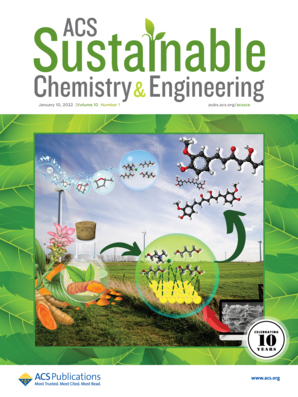蒸汽爆炸对木材细胞壁化学和结构的改变促进真菌生长以生产真菌复合材料
IF 7.1
1区 化学
Q1 CHEMISTRY, MULTIDISCIPLINARY
引用次数: 0
摘要
真菌复合材料是由真菌通过木质纤维素基质生长形成的可持续材料,其生产需要有效的真菌定植原料。该研究强调了蒸汽爆炸(SE)作为一种有效的预处理方法的潜力,可以提高山毛榉木成分在真菌复合材料生产中的生物利用度。木材样品在4种不同程度下经受蒸汽爆炸(R0 3.36;R0 3.65;R0 3.94;R0 4.24),通过动态图像分析、扫描电镜、液滴形貌分析、近红外光谱和阴离子色谱等方法对其化学成分和微观结构进行了分析。通过改变木材颗粒的化学成分和微观结构,SE提高了真菌定植的基质可及性,并产生了含有最少抑制化合物的营养培养基,促进了真菌的最佳生长。研究结果表明,在中度处理(R0 3.36 ~ 3.94)的山毛榉木颗粒上,花色板菌(Trametes versicolor)的生长速率最高,菌丝直径(1.3 μm vs 0.5 μm)较大,其生长速率比R0 4.24提高了46%,比未处理的山毛榉木颗粒提高了138%。这些结果与细颗粒的减少(在R0 4.24下为0.7比11.6%)和更好的吸水率(在R0 4.24下为28比5%)相关。r0.3.65制备的菌丝复合材料的厚度回收率为69%,而r0.3.36为32%,r4.24为41%。真菌生长抑制发生在R0 >;3.7,强调预处理严重程度的临界窗口。这些结果证明了底物表征在平衡消化率和营养完整性方面的重要性,为从木材和难降解生物质中高效和可持续地生产真菌复合材料提供了途径。本文章由计算机程序翻译,如有差异,请以英文原文为准。

Cell Wall Chemical and Structural Changes of Wood by Steam Explosion to Increase Fungal Growth for Myco-Composite Production
The production of myco-composites, sustainable materials formed by fungal growth through lignocellulosic substrates, requires efficient fungal colonization of the feedstock. This study highlights the potential of steam explosion (SE) as an effective pretreatment to enhance the bioavailability of beech wood components for myco-composite production. Wood samples were subjected to steam explosion under four different severities (R0 3.36; R0 3.65; R0 3.94; R0 4.24), and their chemical composition and microstructure were analyzed by dynamic image analysis, scanning electron microscopy, drop shape analysis, near-infrared spectroscopy, and anionic chromatography. By modifying the chemical composition and microstructure of wood particles, SE improves substrate accessibility for fungal colonization and generates a nutrient medium with minimal inhibitory compounds, promoting optimal fungal growth. Our findings reveal that Trametes versicolor exhibits its highest growth rate and larger hyphal diameters (1.3 vs 0.5 μm) on beech wood particles treated at intermediate severities (R0 3.36–3.94) with growth rates increasing by 46% compared to condition R0 4.24 and 138% compared to untreated beech. These results were correlated with a reduction in fine particles (0.7 vs 11.6% at R0 4.24) and better water absorption (28 vs 5% at R0 4.24). The myco-composite produced with R0 3.65 showed 69% thickness recovery compared to 32% (R0 3.36) and 41% (R0 4.24). Fungal growth inhibition occurred at R0 > 3.7, emphasizing the critical window for pretreatment severity. These results demonstrate the importance of substrate characterization in balancing digestibility and nutrient integrity, providing a pathway for the efficient and sustainable myco-composite production from wood and recalcitrant biomass.
求助全文
通过发布文献求助,成功后即可免费获取论文全文。
去求助
来源期刊

ACS Sustainable Chemistry & Engineering
CHEMISTRY, MULTIDISCIPLINARY-ENGINEERING, CHEMICAL
CiteScore
13.80
自引率
4.80%
发文量
1470
审稿时长
1.7 months
期刊介绍:
ACS Sustainable Chemistry & Engineering is a prestigious weekly peer-reviewed scientific journal published by the American Chemical Society. Dedicated to advancing the principles of green chemistry and green engineering, it covers a wide array of research topics including green chemistry, green engineering, biomass, alternative energy, and life cycle assessment.
The journal welcomes submissions in various formats, including Letters, Articles, Features, and Perspectives (Reviews), that address the challenges of sustainability in the chemical enterprise and contribute to the advancement of sustainable practices. Join us in shaping the future of sustainable chemistry and engineering.
 求助内容:
求助内容: 应助结果提醒方式:
应助结果提醒方式:


